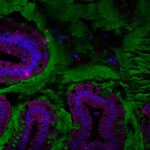Link to Pubmed [PMID] – 28000223
Link to DOI – 10.1113/JP273269
J Physiol 2017 Mar; 595(5): 1831-1846
A high-fat diet (60% kcal from fat) is associated with motility disorders inducing constipation and loss of nitrergic myenteric neurons in the proximal colon. Gut microbiota dysbiosis, which occurs in response to HFD, contributes to endotoxaemia. High levels of lipopolysaccharide lead to apoptosis in cultured myenteric neurons that express Toll-like receptor 4 (TLR4). Consumption of a Western diet (WD) (35% kcal from fat) for 6 weeks leads to gut microbiota dysbiosis associated with altered bacterial metabolites and increased levels of plasma free fatty acids. These disorders precede the nitrergic myenteric cell loss observed in the proximal colon. Mice lacking TLR4 did not exhibit WD-induced myenteric cell loss and dysmotility. Lipopolysaccharide-induced in vitro enteric neurodegeneration requires the presence of palmitate and may be a result of enhanced NO production. The present study highlights the critical role of plasma saturated free fatty acids that are abundant in the WD with respect to driving enteric neuropathy and colonic dysmotility.The consumption of a high-fat diet (HFD) is associated with myenteric neurodegeneration, which in turn is associated with delayed colonic transit and constipation. We examined the hypothesis that an inherent increase in plasma free fatty acids (FFA) in the HFD together with an HFD-induced alteration in gut microbiota contributes to the pathophysiology of these disorders. C57BL/6 mice were fed a Western diet (WD) (35% kcal from fat enriched in palmitate) or a purified regular diet (16.9% kcal from fat) for 3, 6, 9 and 12 weeks. Gut microbiota dysbiosis was investigated by fecal lipopolysaccharide (LPS) measurement and metabolomics (linear trap quadrupole-Fourier transform mass spectrometer) analysis. Plasma FFA and LPS levels were assessed, in addition to colonic and ileal nitrergic myenteric neuron quantifications and motility. Compared to regular diet-fed control mice, WD-fed mice gained significantly more weight without blood glucose alteration. Dysbiosis was exhibited after 6 weeks of feeding, as reflected by increased fecal LPS and bacterial metabolites and concomitant higher plasma FFA. The numbers of nitrergic myenteric neurons were reduced in the proximal colon after 9 and 12 weeks of WD and this was also associated with delayed colonic transit. WD-fed Toll-like receptor 4 (TLR4)-/- mice did not exhibit myenteric cell loss or dysmotility. Finally, LPS (0.5-2 ng·ml-1 ) and palmitate (20 and 30 μm) acted synergistically to induce neuronal cell death in vitro, which was prevented by the nitric oxide synthase inhibitor NG-nitro-l-arginine methyl ester. In conclusion, WD-feeding results in increased levels of FFA and microbiota that, even in absence of hyperglycaemia or overt endotoxaemia, synergistically induce TLR4-mediated neurodegeneration and dysmotility.


